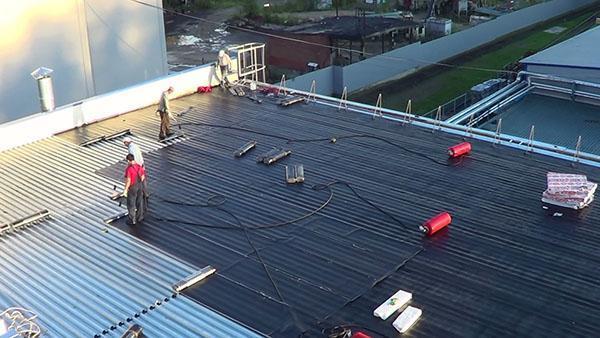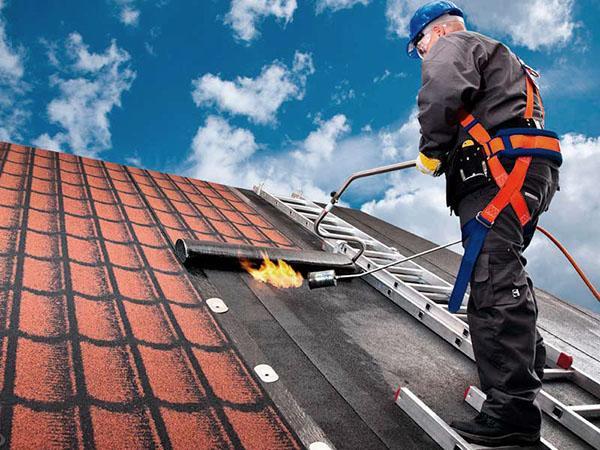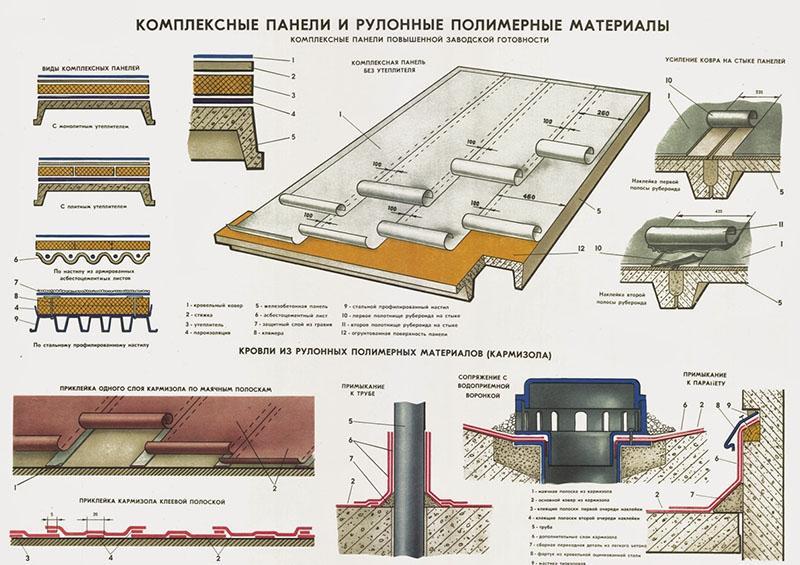In what cases is roll roofing used and the rules for its installation
 Protecting the roof of a building is one of the most important tasks facing the builder. The service life of the coating and the entire structure as a whole depends on what material will be chosen and the correctness of its installation. Roll roofing is one of the most attractive materials.
Protecting the roof of a building is one of the most important tasks facing the builder. The service life of the coating and the entire structure as a whole depends on what material will be chosen and the correctness of its installation. Roll roofing is one of the most attractive materials.
There are several types of rolled roofs that differ in both their composition and installation methods.
How is rolled roofing
The roll roof consists of several layers - heat insulating, waterproofing, reinforcing and material intended for attachment to the surface. Rolled roofing reliably protects the house from exposure to sunlight and moisture, provides the necessary thermal insulation, which leads to significant savings in heating the premises in winter.
The main advantages of the coating

The specialist identifies a number of positive qualities that should be taken into account when choosing a method for coating a roof:
- do not let moisture into the room, but at the same time has good vapor permeability from the side of the room, which provides a healthy microclimate in the room and prevents rotting of structures and the formation of mold;
- installation of rolled roofing can be carried out both on a flat surface and on pitched roofs;
- retains heat in the room due to good thermal insulation;
- has good soundproofing properties, which will protect residents from loud rain or street noise;
- resistance to damage due to the reinforcing layer and elastic structure;
- ease of repair;
- service life up to 40 years;
- ease of transportation and storage.
Roll roofing technology is understandable, but it requires a certain experience and diligence from the employee.
Installation of roll roofing
 Bitumen-based roll roofing is laid by fusion. The roof surface must be dry and thoroughly free of dirt and dust. Work should be done in dry weather. The roll is heated with a gas burner and gradually rolled along the roof surface. It is necessary to ensure that the surface to be welded is sufficiently heated. You must not walk on a freshly laid roof or put objects on it. Rolls are stacked with an overlap specified in the instructions.
Bitumen-based roll roofing is laid by fusion. The roof surface must be dry and thoroughly free of dirt and dust. Work should be done in dry weather. The roll is heated with a gas burner and gradually rolled along the roof surface. It is necessary to ensure that the surface to be welded is sufficiently heated. You must not walk on a freshly laid roof or put objects on it. Rolls are stacked with an overlap specified in the instructions.
The main difficulty in the construction of roofs from roll materials is the method of abutting vertical roof structures. Such mates are arranged in several layers. First, a lining of bituminous material is laid. It should be rolled onto a vertical surface by 30 cm and attached to it with nails. And only then the roll material is laid. There should be no overlapping rolls on the vertical surface.
Self-adhesive roofing is installed thanks to the adhesive base on the material laid on the primed surface.
Types of roofing roll materials
There are several types of roll roofing materials, their purpose and properties differ from each other and can have a specific scope and installation.
Self-adhesive roofing
 It is a multi-layer roll material with a reinforcing layer. The adhesive side of the material is reliably protected with special paper. A self-adhesive roof is available with an adhesive side on both sides. This type of roof is used if it is necessary to lay a decorative coating on it.
It is a multi-layer roll material with a reinforcing layer. The adhesive side of the material is reliably protected with special paper. A self-adhesive roof is available with an adhesive side on both sides. This type of roof is used if it is necessary to lay a decorative coating on it.
The technology of self-adhesive roofing is quite simple. It is necessary to clean the surface from dust and dirt, and then treat it with a primer. Further, rolled roofing materials for the top layer are gradually separated from the total mass, the protective paper is removed and glued with a common sheet on the roof surface. For better adhesion of the roof to the roof and greater evenness, it is necessary to level the rolls with special rollers. The self-adhesive roll roof is overlapped and the seams are hot air treated to create a continuous surface.
Roofing rubber in rolls
 Roofing rubber is a flexible and durable material with excellent sound insulation. It is used mainly in regions with cold climates, where additional requirements for thermal insulation are imposed on the roof. Immune to atmospheric precipitation. During installation, it is laid on a bituminous primer.
Roofing rubber is a flexible and durable material with excellent sound insulation. It is used mainly in regions with cold climates, where additional requirements for thermal insulation are imposed on the roof. Immune to atmospheric precipitation. During installation, it is laid on a bituminous primer.
Roll fiberglass
 It is one of the most wear-resistant and durable roll materials for roofing work. It does not lose its properties at all from any physical treatment and impact - painting, coating with other types of materials, drilling and sawing.
It is one of the most wear-resistant and durable roll materials for roofing work. It does not lose its properties at all from any physical treatment and impact - painting, coating with other types of materials, drilling and sawing.
Roll fiberglass for roofing:
- has phenomenal heat-insulating properties due to low thermal conductivity, comparable to wood;
- it is characterized by high tensile strength, comparable to steel, which makes it possible to place various structures on it or arrange a summer cafe on the roof;
- fiberglass does not react with atmospheric water and is waterproof, therefore it cannot rot;
- not susceptible to direct sunlight, the operating temperature range is from -40 to + 60 ° C.
The most important advantages of the material is that it does not lose its qualities when kinking and bending. It is also non-flammable and does not require high-temperature air welding during installation.
Fiberglass for roofing
 Fiberglass has been gaining popularity as a roofing material for the past 10 years. This is due to its excellent resistance to moisture, corrosion and decay. Fiberglass is also highly durable and resistant to chemicals.
Fiberglass has been gaining popularity as a roofing material for the past 10 years. This is due to its excellent resistance to moisture, corrosion and decay. Fiberglass is also highly durable and resistant to chemicals.
Installation of fiberglass roofing has a number of features. It must not be laid on cement or concrete surfaces and must not come into contact with bitumen. Fiberglass is rarely used for repairing existing roofs, as it requires special installation and properties of the surface on which it is laid.
You can make a roofing sheet with your own hands from fiberglass. To do this, you need to impregnate the fiberglass with a special mastic and cover with a protective film. The result is a durable, well-reinforced material that almost does not bend.
Among other materials, it stands out for its special qualities:
- high strength factor;
- ease of use;
- not susceptible to chemicals;
- good reinforcing qualities;
- resistant to moisture.
These qualities allow fiberglass to be included in the list of the most effective roofing materials.
Bituminous roof covering
 Rolled bitumen coatings are baseless and basic. The difference is that the composition of the main materials includes an additional layer of fiberglass or polyester, which increases the rigidity and strength of the material.
Rolled bitumen coatings are baseless and basic. The difference is that the composition of the main materials includes an additional layer of fiberglass or polyester, which increases the rigidity and strength of the material.
Modern high-quality materials are produced using polymers, which significantly increase the life of the coating.
Polymer-based bituminous coatings are laid in one layer, unlike roofing material.
They are also coverless and coverless. Non-covering materials are used as underlays and are intended for vapor barrier of the coating. Covering materials have a layer of dispersed material - sand or mica on top, which provides additional protection.
 A bituminous roof covering is arranged by fusion. Expensive and complicated equipment for hot air welding is not necessary here. The bituminous coating is laid with a gas burner.
A bituminous roof covering is arranged by fusion. Expensive and complicated equipment for hot air welding is not necessary here. The bituminous coating is laid with a gas burner.
There is such a thing as a combined roll roofing. This is a fairly common type of roofing arrangement, in which there are two directions:
- Inversion. With this model of the device, the insulation is mounted on top of the waterproofing. This reduces the level of temperature fluctuation.
- Traditional. With such a device, waterproofing is laid on top of the insulation. This method is used at technical facilities.
Two types of materials are involved in combined roofs. The advantages of using this method are ease of installation and practicality.
As a result, rolled roofing stands out for its convenience and ease of installation with any chosen material for arranging the roof. These advantages allow the use of roll materials in normal conditions, without requiring special skills and knowledge.
What is the difference between different types of roll roofing - video
